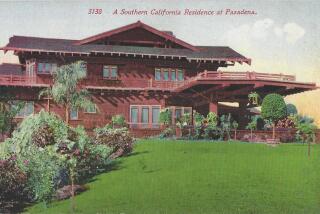City Out of Love With Old Cape Cod : Architecture: The style has been required in downtown Dana Point since the 1970s. But opposition has led to drafting of more liberal rules.
- Share via
DANA POINT — Alex McGeary felt like celebrating.
For years, McGeary has fought to make Dana Point look more like the California coastal city it is instead of the Cape Cod village its laws have required. As the first of 440 spindly palm trees began lining Street of the Golden Lantern this fall, he saw it as a sign that the winds of change are blowing in his direction.
“Hurray,” said McGeary, longtime owner of the Old Dana Point Cafe and Wine Bar and a leader of a downtown merchants group. “We’ve come a long way. The palm tree war is over. Now we can send those Cape Cod standards back to New England where they belong.”
Since the late 1970s, builders have been held to a strict Cape Cod design theme throughout Dana Point’s downtown. Paint colors were limited to blues and grays, and building styles had to conform to the wood-sided structures with steep, gabled roofs that dominate the central portion of the city.
The Cape Cod idea of Dana Point leaders was meant to distinguish the city from its Spanish- and Mission-style neighbors--San Clemente and San Juan Capistrano--as well as to recall its namesake, Boston author Richard Henry Dana.
But today, the strict rules and non-California theme have been targeted for lifting by city planners who are attempting to appease downtown merchants such as McGeary. Last week, Dana Point officials released a draft version of new eclectic building and landscape standards in the first step toward banishing the late 1970s-era Eastern Seaboard look that many architects have grown to dread.
The city’s Planning Commission will begin a review of the standards Dec. 1. If approved, they are expected to go to the City Council early next year. The palm trees were planted outside the downtown area and thus did not have to wait for approval of the rules.
The design rules are as liberal as the old rules were strict, said Edward Knight, the city’s director of development. The concept of a city theme has been discarded and individual building designs will be judged on their merits, not their adherence to a preordained style, Knight said.
“The bent now is toward more quality of design,” Knight said. “We are not really dictating a certain type of roof or a certain type of window anymore. Nothing is precluded now.”
Although McGeary’s battle with the planners was over his desire to plant palm trees that did not fit the Cape Cod landscape standards, he had allies among architects who claim that their artistic hands were tied by the New England style.
“The Cape Cod look has its place, but not as a mandated style,” said Lynn Muir, a Dana Point architect who has been an outspoken critic of the requirements. “Insisting on that look was a very, very bad deal for the city. I prefer using materials like brick and stucco that are indigenous to our area.”
Lance B. Schulte, the city’s senior planner, said the new guidelines would make Dana Point more compatible with sister cities. “This will free the city from the Cape Cod idea. We prefer judging a building on the quality of the design, not necessarily its conformance to a particular style. If it’s Spanish, contemporary or Cape Cod, so be it.”
The Cape Cod look was agreed upon before the community incorporated as a city--when a community group called the Dana Point Citizens for Action met with county planners.
At that time, there was a desire to create an identity for the community because many residents worried that it was becoming a hodgepodge of unsightly triplexes and fourplexes, said Susan Hinman, a 24-year resident of Dana Point.
“There was a concern that we didn’t want to be just like San Juan Capistrano,” Hinman said. “We wanted something different.”
So Cape Cod it was. For the next decade, downtown builders and developers designed a new version of the New England seaboard.
In some cases, the theme has clicked. Perhaps most noteworthy of the style is the 5-year-old, 350-room Dana Point Resort, which has become a landmark on a hill near the harbor.
Penny Elia, the resort’s director of public relations, said the theme has been a boon for the hotel.
“It works great for us,” said Elia, who has been with the resort since it opened. “It has a charm, a style and a grace that works for us. People seem to feel we have a warm house on the hill, which is what it looks like.”
More to Read
Sign up for Essential California
The most important California stories and recommendations in your inbox every morning.
You may occasionally receive promotional content from the Los Angeles Times.











